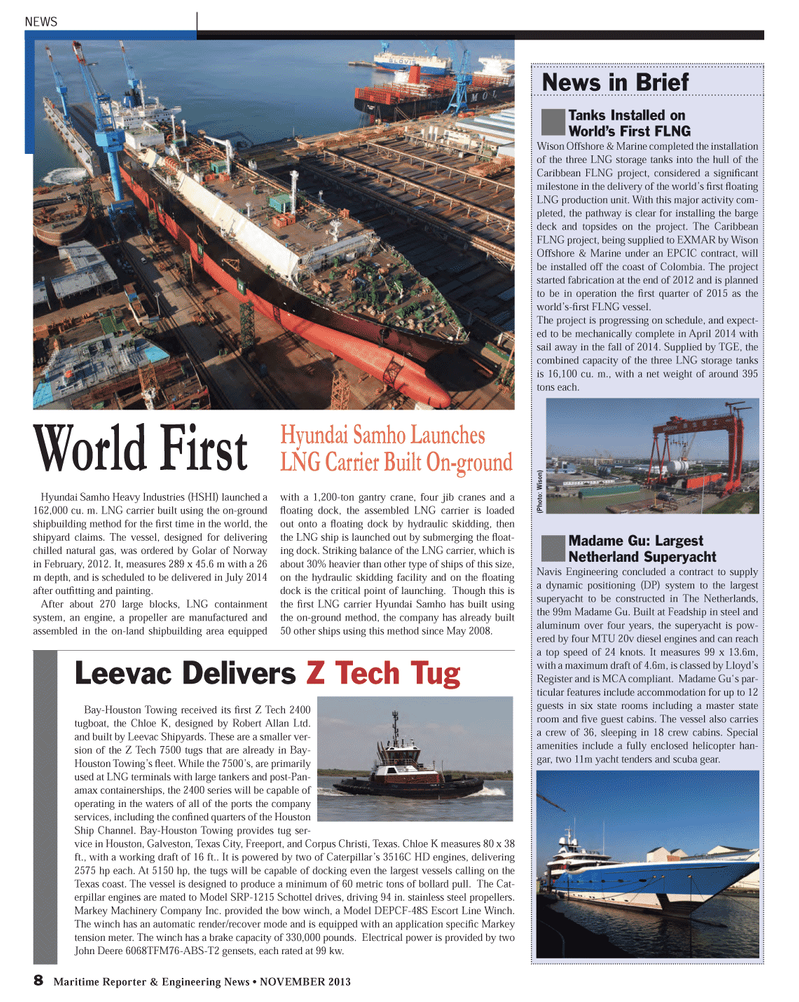
Page 8: of Maritime Reporter Magazine (November 2013)
Marine Propulsion Annual
Read this page in Pdf, Flash or Html5 edition of November 2013 Maritime Reporter Magazine
8 Maritime Reporter & Engineering News ? NOVEMBER 2013 Leevac Delivers Z Tech Tug Bay-Houston Towing received its Þ rst Z Tech 2400 tugboat, the Chloe K, designed by Robert Allan Ltd. and built by Leevac Shipyards. These are a smaller ver- sion of the Z Tech 7500 tugs that are already in Bay- Houston Towing?s ß eet. While the 7500?s, are primarily used at LNG terminals with large tankers and post-Pan- amax containerships, the 2400 series will be capable of operating in the waters of all of the ports the company services, including the conÞ ned quarters of the Houston Ship Channel. Bay-Houston Towing provides tug ser- vice in Houston, Galveston, Texas City, Freeport, and Corpus Christi, Texas. Chloe K measures 80 x 38 ft., with a working draft of 16 ft.. It is powered by two of Caterpillar?s 3516C HD engines, delivering 2575 hp each. At 5150 hp, the tugs will be capable of docking even the largest vessels calling on the Texas coast. The vessel is designed to produce a minimum of 60 metric tons of bollard pull. The Cat- erpillar engines are mated to Model SRP-1215 Schottel drives, driving 94 in. stainless steel propellers. Markey Machinery Company Inc. provided the bow winch, a Model DEPCF-48S Escort Line Winch. The winch has an automatic render/recover mode and is equipped with an application speciÞ c Markey tension meter. The winch has a brake capacity of 330,000 pounds. Electrical power is provided by two John Deere 6068TFM76-ABS-T2 gensets, each rated at 99 kw. NEWSWorld First News in BriefTanks Installed on World?s First FLNG Wison Offshore & Marine completed the installation of the three LNG storage tanks into the hull of the Caribbean FLNG project, considered a signiÞ cant milestone in the delivery of the world?s Þ rst ß oating LNG production unit. With this major activity com- pleted, the pathway is clear for installing the barge deck and topsides on the project. The Caribbean FLNG project, being supplied to EXMAR by Wison Offshore & Marine under an EPCIC contract, will be installed off the coast of Colombia. The project started fabrication at the end of 2012 and is planned to be in operation the Þ rst quarter of 2015 as the world?s- Þ rst FLNG vessel. The project is progressing on schedule, and expect-ed to be mechanically complete in April 2014 with sail away in the fall of 2014. Supplied by TGE, the combined capacity of the three LNG storage tanks is 16,100 cu. m., with a net weight of around 395 tons each. Madame Gu: Largest Netherland SuperyachtNavis Engineering concluded a contract to supply a dynamic positioning (DP) system to the largest superyacht to be constructed in The Netherlands, the 99m Madame Gu. Built at Feadship in steel and aluminum over four years, the superyacht is pow-ered by four MTU 20v diesel engines and can reach a top speed of 24 knots. It measures 99 x 13.6m, with a maximum draft of 4.6m, is classed by Lloyd?s Register and is MCA compliant. Madame Gu?s par- ticular features include accommodation for up to 12 guests in six state rooms including a master state room and Þ ve guest cabins. The vessel also carries a crew of 36, sleeping in 18 crew cabins. Special amenities include a fully enclosed helicopter han-gar, two 11m yacht tenders and scuba gear. LNG Carrier Built On-ground Hyundai Samho LaunchesHyundai Samho Heavy Industries (HSHI) launched a 162,000 cu. m. LNG carrier built using the on-ground shipbuilding method for the Þ rst time in the world, the shipyard claims. The vessel, designed for delivering chilled natural gas, was ordered by Golar of Norway in February, 2012. It, measures 289 x 45.6 m with a 26 m depth, and is scheduled to be delivered in July 2014 after outÞ tting and painting. After about 270 large blocks, LNG containment system, an engine, a propeller are manufactured and assembled in the on-land shipbuilding area equipped with a 1,200-ton gantry crane, four jib cranes and a ß oating dock, the assembled LNG carrier is loaded out onto a ß oating dock by hydraulic skidding, then the LNG ship is launched out by submerging the ß oat-ing dock. Striking balance of the LNG carrier, which is about 30% heavier than other type of ships of this size, on the hydraulic skidding facility and on the ß oating dock is the critical point of launching. Though this is the Þ rst LNG carrier Hyundai Samho has built using the on-ground method, the company has already built 50 other ships using this method since May 2008.(Photo: Wison) MR #11 (1-9).indd 8MR #11 (1-9).indd 811/12/2013 10:23:54 AM11/12/2013 10:23:54 AM

 7
7

 9
9
